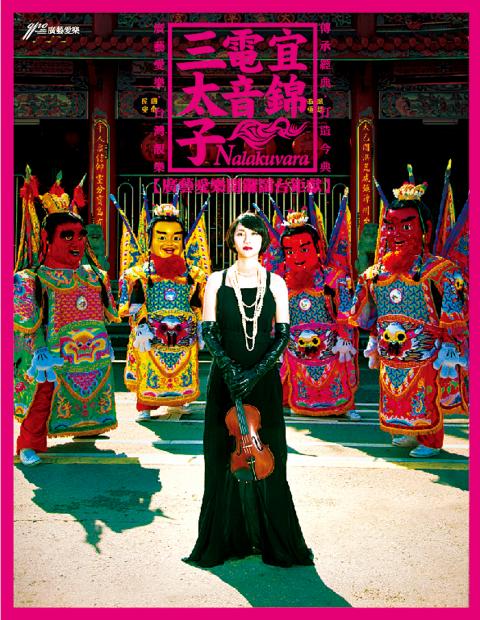A saying in Taiwanese folk belief says that “if you offer incense, you will be protected.” In Taiwan’s entertainment world, there’s a popular song titled “Bobee,” meaning “singing for divine protection.” Now in Taiwan’s classical music world, Quanta Philharmonic Orchestra (QPO) also has something divine to offer, making its debut with a concert entitled Nalakuvara, Sanskrit for the nearest Chinese equivalent “Nezha the third prince,” at the National Concert Hall in Taipei on March 6. Teaming up with the orchestra, the dancing deities will step onto the stage of the National Concert Hall for the first time in history to present a “divine” concert that is meant to “protect the audience.”
QPO asked Taiwanese composer Lee Che-yi, music director of QPO, to compose two original works: Wind Fire Wheel Techno Nalakuvara, a concerto for traditional and electric violin, and Beethoven’s Samsara and Incarnation, a stylistically eclectic symphonic fantasy. As the concert will also be conducted by Tony Huang, known as Taiwan’s Shinichi Chiaki, it promises to cross boundaries in the world of classical music in Taiwan, and will certainly stir up a lot of interest here.
Wind Fire Wheel Techno Nalakuvara features National Symphony Orchestra concertmaster Li I-ching, a beautiful and talented violinist. Li will alternate between traditional and electric violin, exploring new timbres to bring an entirely new listening experience to audiences. Based on Taiwanese gezai opera, nanguan and beiguan music, Taiwanese puppet theater, known as budaixi, and the rhythms of Taike (Taiwanese style) techno music, the composer imbues the rigorous composition of classical music with distinctly Taiwanese elements. In Beethoven’s Samsara and Incarnation, presented in the second half of the concert, the composer blends Taiwanese folk songs, such as “Bang Chhun Hong” (Awaiting the Spring Breeze), with Beethoven style orchestrations and arrangements, reminding audiences that many of the familiar melodies they encounter every day are actually from Beethoven’s works.

Photo courtesy of Quanta Arts Foundation
照片由廣藝基金會提供
The Taoyuan-based QPO — currently the youngest orchestra in Taiwan — was founded by Quanta Computer Chairman Barry Lam in August, 2010. Under the direction of Mel Yang, artistic director of QPO and executive director of Quanta Arts Foundation, the dare-to-dream orchestra is planning to eventually present a rock ‘n’ roll symphony, and a computer game big band, among other ideas. Yang told the Taipei Times yesterday that he hopes QPO will not only be a performing arts group, but also a perfect platform for creative and talented young people.
(Lin Ya-ti, Taipei Times)
台灣民間信仰流傳「有拜有保庇」、台灣娛樂圈則傳唱《有唱有保庇》,台灣古典樂界也不遑多讓,廣藝愛樂管弦樂團三月六日將在台北國家音樂廳創團首演《宜錦‧電音‧三太子》(Nalakuvara是哪吒三太子的梵文音)。三太子也加入樂團,首度踏上國家音樂廳舞台,呈現最「神」的管弦樂,讓觀眾「有聽有保庇」。
樂團邀請到台灣作曲家、同時也是該樂團音樂總監李哲藝,為其打造兩首作品:電子與傳統小提琴協奏曲《風火電音三太子》與混搭風交響幻想曲《貝多芬的前世今生》。同時在素有台版千秋王子之稱的指揮黃東漢的詮釋下,跨越古典樂界,勢必引起一股台灣靚樂旋風。

Photo: Lin Ya-ti, Taipei Times
照片:台北時報林亞蒂
才貌兼具的國家交響樂團首席李宜錦,受邀在《風火電音三太子》演出,交替演奏古典小提琴與電子小提琴,探索豐富音色,將帶給觀眾煥然一新的聽覺體驗。作曲家在該曲中以廟會中歌仔戲、南北管、布袋戲等為創作背景,配上台客電音舞曲的節奏,運用古典音樂嚴謹的編曲結構,創作這首具有濃厚台灣色彩的管弦樂曲。下半場則以混搭風交響幻想曲《貝多芬的前世今生》,作曲家嘗試融合《望春風》等台灣民謠與貝多芬音樂風格的配器與編曲結構,讓觀眾意識到許多生活中熟悉的旋律,即是來自貝多芬之筆。
位於桃園的廣藝愛樂管弦樂團─目前國內最年輕的管弦樂團─是由廣達電腦董事長林百里於二○一○年八月創辦。在廣藝愛樂藝術總監,同時也是廣藝基金會執行長楊忠衡的打造下,敢作夢的廣藝愛樂未來還計畫推出「搖滾交響曲」、「電玩大樂團」等。楊忠衡昨天向《台北時報》表示,他希望樂團不只是個表演團隊,更是一個創意發想及培育年輕人才的平台。
(台北時報記者林亞蒂)

Photo: Lin Ya-ti, Taipei Times
照片:台北時報林亞蒂

Have you ever wondered why “Manila envelopes” carry that name? The answer lies in a plant native to the Philippines. Though a fruit-producing plant, abaca is most valued for its leaf stalks, which are __1__ to extract fibers known as “Manila hemp.” These fibers are known for their strength and resistance to saltwater. Because of its __2__ in sea environments, Manila hemp has long been used to make Manila rope, a staple in the sailing and maritime industries for centuries. It withstands harsh ocean conditions without its flexibility being __3__. Manila rope doesn’t break down easily when exposed to

A: In addition to boyband Energy’s concerts, Taiwan’s first major male dance revue has attracted attention. B: Several South Korean male dance revues and Australia’s Thunder from Down Under often tour Taiwan. Now Taiwan’s first all-male revue has finally appeared. A: According to the Liberty Times, Muscle High: A Male Dance Revue from Taiwan, featuring 13 hunks, opened last month and will run until Sept. 14. B: The rise of “hunk fever” in recent years has even caused a trend of working out in Asia. A: Let’s go to the Taipei Music Center’s Sub Livehouse for the show. A:

A: Any fun events happening this weekend? B: Boyband Energy’s concerts and Taiwan’s first major male dance revue have both sparked anticipation recently. A: Energy staged a comeback last year — 15 years after they disbanded — and they’re now more popular than ever. B: Their megahit “Friday Night” even won Song of the Year at the Golden Melody Awards. A: To pay tribute to the Queen of Pop Madonna, they added her choreography of 16 continuous jump squats to their music video, prompting a “16-squat challenge” that went viral across Taiwan. Do you wanna try it out? A:

In a major step to combat carbon emissions, Norway’s pioneering “Northern Lights project” is set to expand its carbon capture and storage (CCS) capabilities. Backed by energy giants and the Norwegian government, this collaborative project is working to increase its annual carbon storage capacity from 1.5 million to over five million tons. Northern Lights focuses on capturing CO2 emissions from industrial sources across Europe and securely storing them underground. Captured CO2 will be liquefied and transported by ship to the storage facility located off the coast of Norway. It will be injected through pipes into geological formations about 2,600m below the